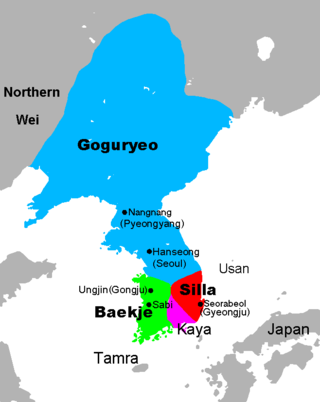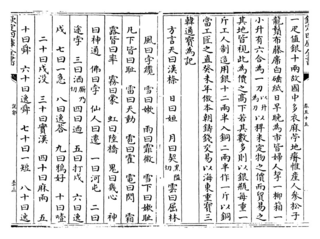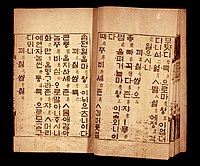
Chinese is a group of languages spoken natively by the ethnic Han Chinese majority and many minority ethnic groups in China. Approximately 1.35 billion people, or around 16% of the global population, speak a variety of Chinese as their first language.

Korean is the native language for about 81 million people, mostly of Korean descent. It is the official and national language of both North Korea and South Korea. The language has notable differences in each of the Koreas, in part owing to different official standardizations of the language. They are still largely mutually intelligible, however. South Korean newspaper Daily NK has claimed North Korea criminalizes the use of the South's standard language with the death penalty, and South Korean education and media often portray the North's language as alien and uncomfortable.

Hanja, alternatively known as Hancha, are Chinese characters used in the writing of Korean. Hanja was used as early as the Gojoseon period under the first Korean kingdom.
The languages of East Asia belong to several distinct language families, with many common features attributed to interaction. In the Mainland Southeast Asia linguistic area, Chinese varieties and languages of southeast Asia share many areal features, tending to be analytic languages with similar syllable and tone structure. In the 1st millennium AD, Chinese culture came to dominate East Asia, and Classical Chinese was adopted by scholars and ruling classes in Vietnam, Korea, and Japan. As a consequence, there was a massive influx of loanwords from Chinese vocabulary into these and other neighboring Asian languages. The Chinese script was also adapted to write Vietnamese, Korean and Japanese, though in the first two the use of Chinese characters is now restricted to university learning, linguistic or historical study, artistic or decorative works and newspapers, rather than daily usage.
Sino-Koreanvocabulary or Hanja-eo refers to Korean words of Chinese origin. Sino-Korean vocabulary includes words borrowed directly from Chinese, as well as new Korean words created from Chinese characters, and words borrowed from Sino-Japanese vocabulary. Many of these terms were borrowed during the height of Chinese-language literature on Korean culture. Subsequently, many of these words have also been truncated or altered for the Korean language.

Japonic or Japanese–Ryukyuan, sometimes also Japanic, is a language family comprising Japanese, spoken in the main islands of Japan, and the Ryukyuan languages, spoken in the Ryukyu Islands. The family is universally accepted by linguists, and significant progress has been made in reconstructing the proto-language, Proto-Japonic. The reconstruction implies a split between all dialects of Japanese and all Ryukyuan varieties, probably before the 7th century. The Hachijō language, spoken on the Izu Islands, is also included, but its position within the family is unclear.
Sino-Japanese vocabulary, also known as kango, is a subset of Japanese vocabulary that originated in Chinese or was created from elements borrowed from Chinese. Some grammatical structures and sentence patterns can also be identified as Sino-Japanese.

The Goguryeo language, or Koguryoan, was the language of the ancient kingdom of Goguryeo, one of the Three Kingdoms of Korea. Early Chinese histories state that the language was similar to those of Buyeo, Okjeo and Ye. Lee Ki-Moon grouped these four as the Puyŏ languages. The histories also stated that these languages were different from those of the Yilou and Mohe. All of these languages are unattested except for Goguryeo, for which evidence is limited and controversial.
Sino-Xenic or Sinoxenic pronunciations are regular systems for reading Chinese characters in Japan, Korea and Vietnam, originating in medieval times and the source of large-scale borrowings of Chinese words into the Japanese, Korean and Vietnamese languages, none of which are genetically related to Chinese. The resulting Sino-Japanese, Sino-Korean and Sino-Vietnamese vocabularies now make up a large part of the lexicons of these languages. The pronunciation systems are used alongside modern varieties of Chinese in historical Chinese phonology, particularly the reconstruction of the sounds of Middle Chinese. Some other languages, such as Hmong–Mien and Kra–Dai languages, also contain large numbers of Chinese loanwords but without the systematic correspondences that characterize Sino-Xenic vocabularies.
Old Korean is the first historically documented stage of the Korean language, typified by the language of the Unified Silla period (668–935).
The Hamgyŏng dialect, or Northeastern Korean, is a dialect of the Korean language used in most of North and South Hamgyŏng and Ryanggang Provinces of northeastern North Korea, all of which were originally united as Hamgyŏng Province. Since the nineteenth century, it has also been spoken by Korean diaspora communities in Northeast China and the former Soviet Union.
This article is a technical description of the phonetics and phonology of Korean. Unless otherwise noted, statements in this article refer to South Korean standard language based on the Seoul dialect.
The traditional periodization of Korean distinguishes:
The Chinese Korean language is the variety of the Korean language spoken by Koreans in China who have Chinese nationality, primarily located in Heilongjiang, Jilin, and Liaoning.
Proto-Japonic, Proto-Japanese, or Proto-Japanese–Ryukyuan is the reconstructed language ancestral to the Japonic language family. It has been reconstructed by using a combination of internal reconstruction from Old Japanese and by applying the comparative method to Old Japanese and Ryukyuan languages. The major reconstructions of the 20th century were produced by Samuel Elmo Martin and Shirō Hattori.

Koreanic is a small language family consisting of the Korean and Jeju languages. The latter is often described as a dialect of Korean, but is distinct enough to be considered a separate language. Alexander Vovin suggested that the Yukjin dialect of the far northeast should be similarly distinguished. Korean has been richly documented since the introduction of the Hangul alphabet in the 15th century. Earlier renditions of Korean using Chinese characters are much more difficult to interpret.

The Yale romanization of Korean was developed by Samuel Elmo Martin and his colleagues at Yale University about half a decade after McCune–Reischauer. It is the standard romanization of the Korean language in linguistics.

The Korean alphabet, known as Hangul in South Korea and Chosŏn'gŭl (조선글) in North Korea, is the modern official writing system for the Korean language. The letters for the five basic consonants reflect the shape of the speech organs used to pronounce them, and they are systematically modified to indicate phonetic features; similarly, the vowel letters are systematically modified for related sounds, making Hangul a featural writing system. It has been described as a syllabic alphabet as it combines the features of alphabetic and syllabic writing systems.

The Jilin leishi was a Chinese book about Korea written in 1103–1104 by Sūn Mù (孫穆), an officer of the Chinese Song dynasty embassy to Goryeo. The original work is lost, but fragments reproduced in later Chinese works provide vital information about Early Middle Korean.
The Yukjin dialect is a variety of Korean or a Koreanic language spoken in the historic Yukjin region of northeastern Korea, south of the Tumen River. Its phonology and lexicon are unusually conservative, preserving many Middle Korean forms. Thus, Alexander Vovin classified it as a distinct language.










